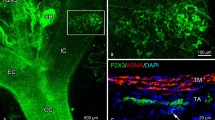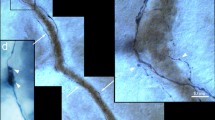Summary
The carotid body of the monkey (Macaca fascicularis) was studied at both the light and electron microscopic levels in an effort to provide a detailed quantitative characterization of this chemoreceptor organ in the primate. Structurally, the monkey carotid body was organized into lobules of from three to eight glomus cells (in section) and their ensheathing supporting cells. Interspersed among the lobules was abundant connective tissue stroma, fibroblasts and mast cells. Fenestrated capillaries, small arterioles and venules also permeated the organ. Each supporting cell partially ensheathed about three glomus cells and could be easily differentiated from glomus cells by their darker cytoplasmic staining, lack of dense-core vesicles and angular nuclear profile. Glomus cells exhibited an intense catecholamine histofluorescence and contained abundant dense-core vesicles. On the basis of dense-core vesicle size, shape and numerical density, four types of glomus cells were identified. The most common type (62% of all glomus cells) contained vesicles with an average diameter of 219 nm and a density of 8 vesicles per μm2 of cytoplasm. The second type possessed larger vesicles (264 nm in diameter) and accounted for about 14% of all glomus cells. A third type of glomus cell contained smaller (167 nm) and fewer (5 vesicles per μm2) dense-core vesicles. The fourth type of glomus cell contained pleomorphic-shaped vesicles with a maximal diameter of 232 nm. Each of these last two types accounted for about 12% of all glomus cells. All four types of glomus cells were innervated, averaging 1.43 nerve endings per glomus cell (in sections). Nerve endings were primarily of the bouton-like variety averaging 2 μm2 in sectional area and containing 34.3 clear-core synaptic vesicles (average size 73.5 nm in diameter) per μm2 of cytoplasm. Of the 57 nerve endings examined in single sections, 16% displayed junctions typical of synaptic specializations and most of these were presynaptic to glomus cells. Glomus cell-glomus cell synapses were not observed. Based on these quantitative observations and on previous studies of carotid body cytoarchitecture in other laboratory species, it appears that the primate organ most closely resembles the cat carotid body, although several differences exist.
Similar content being viewed by others
References
Al-Lami, F. &Murray, R. G. (1968a) Fine structure of the carotid body ofMacaca mulatta monkey.Journal of Ultrastructure Research 24, 465–78.
Al-Lami, F. &Murray, R. G. (1968b) Fine structure of the carotid body of normal and anoxic cats.Anatomical Record 160, 697–718.
Biscoe, T. J. &Stehbens, W. E. (1966) Ultrastructure of the carotid body.Journal of Cell Biology 30, 563–78.
Bloom, F. E. &Battenberg, E. L. F. (1976) A rapid, simple and sensitive method for the demonstration of central catecholamine-containing neurons and axons by glyoxylic acid-induced fluorescence. II. A detailed description of methodology.Journal of Histochemistry and Cytochemistry 24, 561–71.
De la Torre, J. C. &Surgeon, J. W. (1976) A methodological approach to rapid and sensitive monoamine histofluorescence using a modified glyoxylic acid technique: The SPG method.Histochemistry 49, 81–93.
Hansen, J. T. (1984) The rat peripheral chemoreceptors: a comparative ultrastructural study of the carotid and aortic bodies. InThe Peripheral Arterial Chemoreceptors (edited byPallot, D. J.), pp. 161–9. London: Croom Helm Ltd.
Heath, D., Jago, R. &Smith, P. (1983) The vasculature of the carotid body.Cardiovascular Research 17, 33–42.
Kjaergaard, J. (1973)Anatomy of the Carotid Glomus and Carotid Glomus-like Bodies (Nonchromaffin Paraganglia). Copenhagen: FADL's Forlag.
Mayhew, T. M. (1979) Stereological approach to the study of synapse morphometry with particular regard to estimating number in a volume and on a surface.Journal of Neurocytology 8, 121–38.
McDonald, D. M. (1981) Peripheral chemoreceptors: structure-function relationships of the carotid body. InRespiratory Control and Clinical Applications, Vol. 17 (Part 1)Lung Biology in Health and Disease (edited byHornbein, T. F.), pp. 105–319. New York: Marcel Dekker Inc.
McDonald, D. M. &Mitchell, R. A. (1975) The innervation of glomus cells, ganglion cells and blood vessels in the rat carotid body: a quantitative ultrastructural analysis.Journal of Neurocytology 4, 177–230.
Morita, E., Chiocchio, S. R. &Tramezzani, J. H. (1969) Four types of main cells in the carotid body of the cat.Journal of Ultrastructure Research 28, 399–410.
Nishi, K. (1976) Serial section analysis of the ultrastructure of nerve endings and glomus cells in the carotid body. InMorphology and Mechanisms of Chemoreceptors (edited byPaintal, A. S.), pp. 1–12. Delhi: Vallabhbhai Patel Chest Institute.
Verna, A. (1979) Ultrastructure of the carotid body in the mammals.International Review of Cytology 60, 271–330.
Wejbel, E. R. (1979)Stereological Methods, Vol. 1,Practical Methods for Biological Morphometry. New York: Academic Press.
Williams, M. A. (1977) Quantitative methods in biology. InPractical Methods in Electron Microscopy, Vol. 6 (edited byGlauert, A. M.), pp. 5–84. Amsterdam: North-Holland Publ. Co.
Author information
Authors and Affiliations
Rights and permissions
About this article
Cite this article
Hansen, J.T. Ultrastructure of the primate carotid body: a morphometric study of the glomus cells and nerve endings in the monkey (Macaca fascicularis). J Neurocytol 14, 13–32 (1985). https://doi.org/10.1007/BF01150260
Received:
Revised:
Accepted:
Issue Date:
DOI: https://doi.org/10.1007/BF01150260




